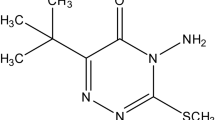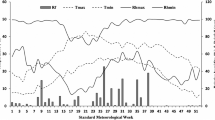Abstract
Dissipation of Quinalphos (Ekalux 20 AF) and Methomyl (Lannate 12.5 L) residues were studied in/on Okra (var. Pusa Sawani) fruits and cropped soil at Baruipur, West Bengal, India. The insecticides were applied at 21 days after sowing by foliar spray at the recommended and double the recommended dose (i.e. 500 and 1,000 g a.i. ha−1 in both the cases). Four sprays were given at 15 days interval in all the cases. The initial build-up residue on Okra fruits was to the magnitude of 3.20 and 7.50 μg g−1 for Quinalphos, 5.61 and 8.42 μg g−1 for Methomyl at lower and higher doses respectively. The half-lives (t1/2) in Okra fruit were found to be 1.25–1.43 days for Quinalphos and 0.88–0.94 days for Methomyl. The safe waiting period (TMRL) determined were 6.7 and 5.3 days at the lower dose of Quinalphos. The corresponding waiting period for Methomyl were 5.7 and 4.9 days. Decontamination process like washing and cooking dislodged 25.50%–81.50% residue depending on insecticides and doses, whereas 20.00%–69.60% surface residue was removed by washing alone. The residues of both insecticides in soil persisted for 6–8 days depending on dose. The half-lives in soil were found to be 1.07–1.20 days for Quinalphos and 0.97–1.25 days for Methomyl.
Similar content being viewed by others
References
Awasthi MD, Anand L, Moorthy PNK, Sarode SV (1984) Movement and distribution pattern of the residue of granular insecticides in tropical soil and Okra plants. Plant Soil 81(3):445–449
Awata BG, Dwlya VP, Rajput KG (1984) Field evaluation of some newer insecticide for the control of Jassids (Amrasca bigutulla bigutulla Ishida) on Bhendi. Pestology 8:7, 14–15
Banerjee K, Upadhyay AK, Adsule P, Pandurang G, Patil SH, OulKar DP, Jadan DR (2006) Rate of degradation of λ-cyhalothrin and methomyl in grapes (Vitis vinifera L.). Food Addit Contam 23:10, 994–999
Easwaramurthi S, Dulliah S, Utuama Swami S (1976) Efficacy of certain insecticides against the sucking pest of Bhendi (Abelmoschus esculentus). Madras Agric J 63(4):254–256
Kumari B, Madan VK, Singh J, Singh S, Kathpal TS (2004) Monitoring of pesticidal contamination of farm gate vegetables from Hissar. Environ Monit Assess 90:1–3
Acknowledgment
We are very grateful to M/S Syngenta Ltd, Mumbai, for sponsoring this research program.
Author information
Authors and Affiliations
Corresponding author
Rights and permissions
About this article
Cite this article
Aktar, M.W., Sengupta, D. & Chowdhury, A. Degradation Dynamics and Persistence of Quinolphos and Methomyl In/On Okra (Ablemoschus esculentus) Fruits and Cropped Soil. Bull Environ Contam Toxicol 80, 74–77 (2008). https://doi.org/10.1007/s00128-007-9319-z
Received:
Accepted:
Published:
Issue Date:
DOI: https://doi.org/10.1007/s00128-007-9319-z




